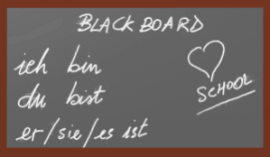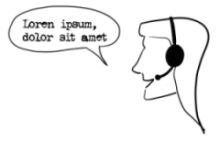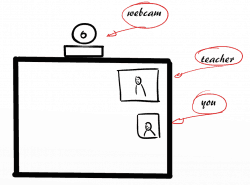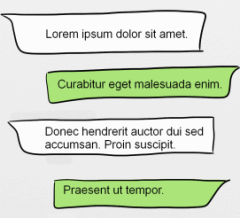Learn German in a virtual classroom
Experience the most cost-efficient and enjoyable way to learn German through my online virtual classroom. Say goodbye to dull and mundane lessons!
With my interactive and engaging online language classes, you’ll feel as if you’re in a traditional classroom with your classmates.
I am expert at maintaining high levels of student engagement, ensuring you stay focused and motivated throughout the learning process. Just take a look at the artwork below to see what might happen if your attention wavers!
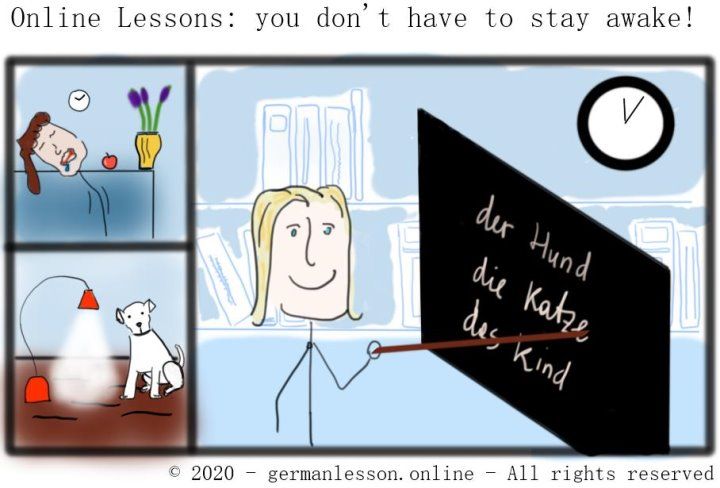
But fear not, even if you happen to doze off during a lesson, my virtual German language course offers the incredible option to record each session for later review.
Join my online lessons, where you’ll be part of a small group of up to 6 participants, providing ample opportunities to express yourself and actively participate in every class. Learning German has never been this enjoyable and convenient!
What is a virtual classroom?
In the world of virtual classrooms, the future of group learning unfolds in an online - or virtual - space. Embracing modernity, this innovative approach brings together students and a tutor, creating a real classroom experience through the power of the internet and specialized software.
In my German virtual classroom, I prioritize quality education by limiting each session to a maximum of 6 language learners. By keeping the class size small, I ensure an efficient and personalized learning experience for every participant.
For those seeking an even more individualized approach, I offer two other enticing options: the 1:1 class, where you get undivided attention from the tutor, and the pair-class, catering to the needs of just two students.
Whichever route you choose, rest assured that your journey to mastering the German language will be engaging, effective, and tailored to suit your preferences.
Get ready to excel in German with my dynamic virtual classroom settings!
About me, your German tutor 👩🏫
In 2012 I graduated in Linguistics from Munich’s University. Since then, I have been tutoring languages for thirteen years. Teaching languages to people from all over the world 🌏, to children, adults and senior, in individual and group courses.
Only recently I have launched my online language teaching service. With a special attention to the best techniques and strategies to learn the German language completely online.
The language courses
Let’s explore different categorizations of language classes based on various factors:
1. Frequency of Lessons:
- Soft. Ideal for a calm and steady approach, with classes held once or twice a week, ensuring solid foundations. This option is popular among learners with no urgent time constraints.
- Intensive. Designed for those with time-sensitive goals. With classes held daily for two hours, this immersive approach enables rapid progress, making you proficient in German in a short time.
- Semi-intensive. Striking a balance between soft and intensive, this option involves two lessons twice a week, providing a focused learning experience.
2. Targeted Learners:
- Children 🧒. Engaging language classes filled with fun and play, tailored for young learners. These sessions use child-friendly teaching methods and last up to 45 minutes to ensure maximum attention.
- Companies. Customized courses for employees integrating into a German working environment. Many companies sponsor German courses for their foreign staff to enhance their integration and communication skills.
- Nurses or Doctors. Special courses designed for addressing the significant shortage of healthcare professionals in German-speaking countries. These courses prepare medical professionals for their roles in the region.
3. Purpose of Learning:
- Holidays 🏖️. Planning a trip to Germany? Opt for a German crash-course to grasp the basics and develop a good understanding of the language for your vacation. Practice pronunciation to impress your travel companions.
- Language test preparation 📋. For learners aiming to take various German exams like testDAF, Goethe-Zertifikat, telc, or DSH, specialized courses are available. These courses focus on the specific content and offer intensive preparation due to often tight deadlines.
- Conversation course 💬. If your goal is to become a confident and fluent speaker, a conversation-focused class is the way to go. Emphasizing natural language acquisition and cultural understanding, this course minimizes grammar lessons and maximizes practical language skills.
No matter your language learning needs, there’s a tailored German course waiting for you! Choose the one that aligns with your goals and preferences, and embark on an exciting journey to master the German language.
Talking German
Certainly, one of the primary goals of taking a German course is to be able to interact confidently with other German speakers. But, speaking German like a native? At first glance, it may seem like an unattainable dream, something that would require years of practice.
However, in my language course, I believe in setting realistic targets for each student. Together, we’ll define achievable objectives and chart a path to reach them, all while keeping you motivated and ensuring your efforts yield the best possible results.
Our approach begins by assessing your current German language level. From there, we’ll work step-by-step to improve your skills, following a proven curriculum that draws from many years of successful teaching experience.
Setting a target can be as simple as identifying a specific German language level you aim to reach, such as A1, for example. Having a clear level in mind is already an excellent target, as language proficiency levels are well-defined and universally recognized.
If you’re unfamiliar with the language levels, don’t worry; I’ll guide you through them. My aim is to make language learning accessible and enjoyable, ensuring you have all the support you need to achieve your goals.
Language level 🌡️
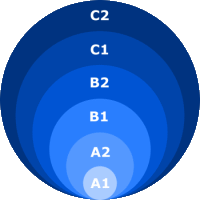
In Europe, the levels of proficiency are indicated with A1, A2, B1, B2, C1, C2.
Let’s see what these levels mean:
- levels A1 and A2 refer to a beginner knowledge level of German. At the end of the course, you know most of the grammar and will be able to elaborate easy sentences with a limited German vocabulary
- levels B1 and B2 refer to an intermediate level. You have a fair comprehension of the language, starting to be independent in your use of the language
- levels C1 and C2 indicate advanced German knowledge. You are completely independent and can get away in any situation requiring advanced linguistic knowledge. You are fluent in any situation
Because I’m a native speaker teacher I can cover all levels of the language. Let’s just see what language skills you currently have and what level you want to reach! It will be our journey to learning German.


